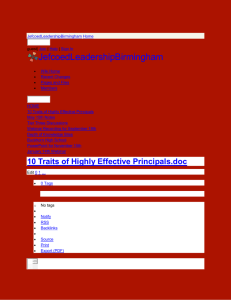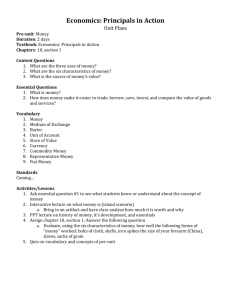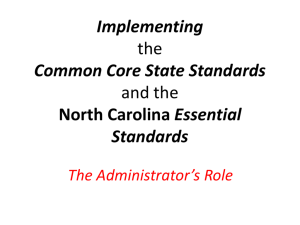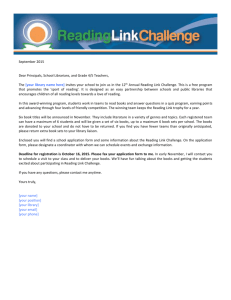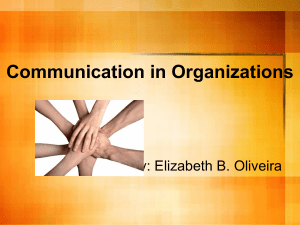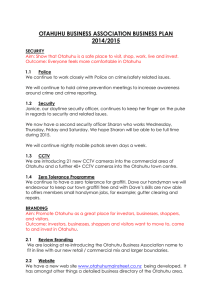Case Study on engagement in AIMHI Schools
advertisement
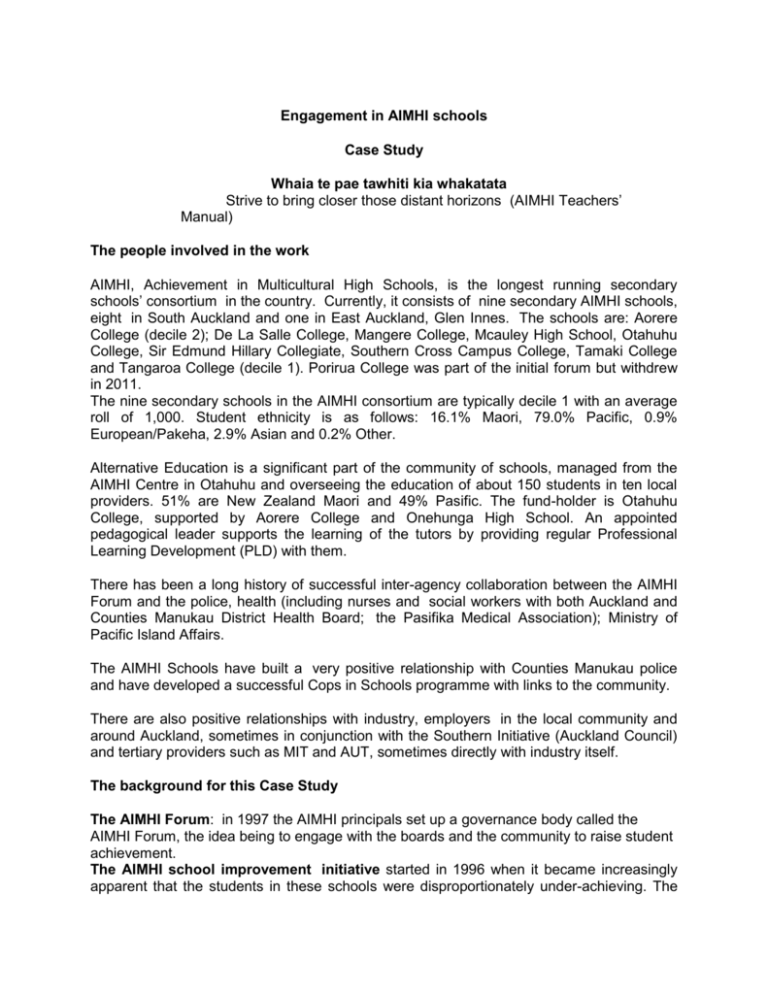
Engagement in AIMHI schools Case Study Whaia te pae tawhiti kia whakatata Strive to bring closer those distant horizons (AIMHI Teachers’ Manual) The people involved in the work AIMHI, Achievement in Multicultural High Schools, is the longest running secondary schools’ consortium in the country. Currently, it consists of nine secondary AIMHI schools, eight in South Auckland and one in East Auckland, Glen Innes. The schools are: Aorere College (decile 2); De La Salle College, Mangere College, Mcauley High School, Otahuhu College, Sir Edmund Hillary Collegiate, Southern Cross Campus College, Tamaki College and Tangaroa College (decile 1). Porirua College was part of the initial forum but withdrew in 2011. The nine secondary schools in the AIMHI consortium are typically decile 1 with an average roll of 1,000. Student ethnicity is as follows: 16.1% Maori, 79.0% Pacific, 0.9% European/Pakeha, 2.9% Asian and 0.2% Other. Alternative Education is a significant part of the community of schools, managed from the AIMHI Centre in Otahuhu and overseeing the education of about 150 students in ten local providers. 51% are New Zealand Maori and 49% Pasific. The fund-holder is Otahuhu College, supported by Aorere College and Onehunga High School. An appointed pedagogical leader supports the learning of the tutors by providing regular Professional Learning Development (PLD) with them. There has been a long history of successful inter-agency collaboration between the AIMHI Forum and the police, health (including nurses and social workers with both Auckland and Counties Manukau District Health Board; the Pasifika Medical Association); Ministry of Pacific Island Affairs. The AIMHI Schools have built a very positive relationship with Counties Manukau police and have developed a successful Cops in Schools programme with links to the community. There are also positive relationships with industry, employers in the local community and around Auckland, sometimes in conjunction with the Southern Initiative (Auckland Council) and tertiary providers such as MIT and AUT, sometimes directly with industry itself. The background for this Case Study The AIMHI Forum: in 1997 the AIMHI principals set up a governance body called the AIMHI Forum, the idea being to engage with the boards and the community to raise student achievement. The AIMHI school improvement initiative started in 1996 when it became increasingly apparent that the students in these schools were disproportionately under-achieving. The purpose of the initiative was to raise student achievement in a number of ways. The aims were to increase the rolls of the participating schools, and to improve attendance of existing students; raise the levels of performance of the schools and students in the areas of: student achievement, governance and management, school/community relationships; integrated social services support policy achieve sustainable self-managing schools. The research and subsequent report by Hawke and Hill, ‘Aiming for Student Achievement’, 1996, highlighted the issues and made suggestions to support better engagement of students and their families with school. They reported that ‘being in a healthy and teachable state is a prerequisite for effective learning’. The feedback from students outlined the qualities students wanted in their teachers, both high levels of subject and pedagogical knowledge. A feature of the organisation is the principals’ monthly meetings where a number of items are discussed. There is support for new principals; joint planning across schools in a number of areas, for example, biology in conjunction with the facilities at Kokako Lodge; policing matters student welfare; social services; Counties Manukau health; the Southern Initiative; Alternative Education, Ministry of Pacific Island Affairs. ‘My reflection is that of a new Principal to the AIMHI cluster. Participating with the Principals of the AIMHI schools has been of great benefit to me and my leadership role at De La Salle College. I have been fortunate to experience and learn from the accumulated knowledge and experience that my fellow school leaders have built up through their years of work in the AIMHI group. Belonging to this group has allowed me to receive support and advice on issues that are unique to the AIMHI educational context while giving me the confidence to trial new initiatives within my school setting. The AIMHI Principal’s group engenders a collegial spirit among Principals, all of whom are happy to share ideas that have been successful in their schools for the benefit of the cluster. I have enjoyed contributing to the collective voice and power that the AIMHI Principal’s group has in advocating for the youth of this community’ (Myles Hogarty, Principal, De La Salle College). In 2002, the AIMHI Centre for Educational Support was opened by Mary Sinclair, Manager of Monitoring and Support, Ministry of Education. The building at 10 Beatty Street, Otahuhu, which houses Alternative Education has a board room called the Kokako Room where the principals meet and from where professional learning development (PLD) is run for AIMHI Schools and the wider community. Each AIMHI school has a plaque designed by students at Mangere College with the inscription: ‘We are proud to be a member of the AIMHI family of schools’. AIMHI Awards evening: at the end of each year there is an awards’ evening for teachers, support staff and members of the Boards of Trustees. The teachers chosen have provided high quality education for the students, some in the classroom others in outdoor pursuits. Each school nominates up to three recipients, one in each category. A citation is read out and a specially designed certificate presented. There is always a guest speaker from the community. Last year, Alfred Ngaro, National list MP, spoke on behalf of the Honourable Hekia Parata. Through this event which started in 2000, governance, leadership and excellence in teaching is acknowledged. (see Gallery on the AIMHI website) “The annual awards for teachers and people who have contributed effectively to AIMHI school leadership for the last 14 years is a well-respected and acknowledged event in the calendar. Families attend to support this occasion and the certificates, designed by a Mangere College Student, can be seen in prominent places in schools and homes.” (Robin Staples, Principal, Southern Cross Campus College) Case study outcomes and impact Research shows that students who are healthy and in a safe environment at school learn better. The AIMHI schools with large numbers of polynesian students were not providing the right educational outcomes for their students. Many felt ‘socially and/or culturally dislocated and not enjoying and achieving education success’. Many had health problems that kept them from school. Three of the schools had been in danger of closing before the forum was set up. Such a serious situation prompted serious action. School leaders realised they had to put the learner at the centre of the solution, that collective action was more likely to achieve success than working in isolation. Healthy Community Schools 2003-2008 (see Price Waterhouse report) One of the aims of the Healthy Community Schools in AIMHI Schools was to see if improved educational outcomes could be achieved by addressing the health and welfare needs of students. As a result of consistent health interventions over this period of time, it is reported in the evaluation that the educational results and retention levels of the students in the AIMHI schools compared with students in other decile 1 schools was higher, and truancy was lower. Students and staff who were surveyed ‘expressed increasingly positive views on services and their willingness to use them’. Students’ perceptions: ‘Someone that understands you, listens to every word and keeps your secrets.’ Some students reported having more confidence in their own health; having the opportunity to set different expectations for themselves in terms of the way they were prepared to live. Teachers’ perceptions: ‘If the students are healthier, their problems dealt with, and they are safe, they do better. This is not rocket science’. The teachers found that the presence of the health service ion the school ‘enabled students’ health issues to be dealt with more effectively, which had a positive effect on learning’. Parent’s perception: ‘As a parent I think the health service is good. The nurse got hold of me about my daughter and we got her hearing fixed up. The nurse got her seen by the doctor and got it sorted out.’ Of those parents who responded to the survey, 91 percent said they were particularly pleased that the school had a health service. An example of the way AIMHI Principals engage with the community at large is when they take up the challenge to speak at important occasions. For instance, in 2012, the Chairperson of the AIMHI Forum, Ngaire Ashmore, was invited to address the Institute of Judicial Studies on issues of poverty in the AIMHI schools. She took along with her two senior students, one Maori and one Pasific, to talk about how they had succeeded at school despite coming from an impoverished background. They were interested in following a career in law. Ngaire told the judges present about the aspirations of the AIMHI Forum of schools, to work collectively for the the good of our schools and our collective communities. to create successful partnerships with education, health and social services, police, employers, industry and other groups within our immediate and wider community, and with family and whanau. The success of young Pasifika and Maori students remains a prime motivator for the AIMHI principals. They engage in constructive problem solving discussions to find a way forward for the success of all, following the principles of Tataiako. They support, for instance, not only vitally important opportunities in the classroom but also involvement with sport, Polynesian Festival, music and art in the wider community. ‘During my ten years as a AMIHI principal, I have found the collegiality of the group a wonderful support. Initially as a principal new to a AIMHI school and subsequently as an experienced principal, the group has acted as a sounding board for successes. We have shared aims for the future, supported each other in times of need and present a wonderful united front when dealing with common issues that we all face. As a unified body we have made a difference to education in the South Auckland communities.’ ( Anne Miles, Principal, Mcauley High School). Improvement achieved for all children and young people. There have been a number of improvements both within and outside the school. They include: teachers working to improve outcomes for students; teachers working with teachers within the AIMHI community; teachers and parents working together both in the school and in the community. While not all ‘young people are socially and culturally located and are enjoying and achieving education success’, they are being given every opportunity to succeed according to their strengths. Most AIMHI schools have seen significant gains in student achievement through the introduction of Starpath, a programme introduced by the University of Auckland which ‘aims to address New Zealand’s comparatively high rate of educational inequality with Māori and Pacific students, and students from low socio-economic backgrounds showing significant rates of educational under-achievement compared with their peers.’(Starpath website). Staff have attended PLD across the curricula to improve their practice. Through Starpath the development of Data Utilisation, Academic Counselling, and Target Setting (DUACTS) have enabled schools to analyse student data more Other ways the AIMHI schools have continued to upskill teachers has been through targetted PLD at the AIMHI Centre in Otahuhu. Team Solutions has run PLD for HODs English, NCEA English, Pasifika Languages. Teacher Aide workshops run by the MOE have been held every two years since 2008. There continues to be a Teacher Aide cluster meeting once a term, held at the AIMHI Centre or in one of the schools. The Southern Cross RTLB cluster uses the AIMHI Centre regularly for PLD as does Alternative Education through the pedagogical leader. effectively and redesign lessons appropriately. Three way conferencing has brought family and whanau into schools in a way not achievable through the conventional parent teacher evenings. To encourage families to come to the school for academic conferencing, staff have made personal invitations by writing letters, bi-lingual in some cases, ringing home, providing child-minding facilities at the school to help look after the small children eg a bouncy castle in one school, barbeques in others. An action that is currently being implemented by most of the AIMHI schools is through Positive Behaviour for Learning (PB4L). It has been introduced in most AIMHI schools with reported success. Although still in its infancy, PB4L is designed to change the problem behaviour of learners by changing the environment around them. As a result, there has been an increase in engagement between home and family. A positive learner is more likely to be a successful learner. ‘’We have had a positive experience in implementing PB4L strategies. The clear identification of times in the day when issues between students arise and our ability to place resources so that such issues are mitigated has been a factor in its success. The identification of the issue of lateness in period 1 as a point of tension between teaching staff and students, again also allowed us to allocate resources so that families would be involved as soon as possible. This has led to a significant decrease in period 1 lateness. ‘ (John Heyes, Principal, Mangere College) An example of success in Education Outside The Classroom (EOTC) is exemplified in the well run Kokako Lodge facility in the Hunua Ranges. The trust of Kokako Lodge was formed in 2000 with the explicit purpose of providing AIMHI students with an outdoor education facility that was affordable and provided safe, challenging high quality programmes in a location close to the schools. Two AIMHI principals have always sat on the Trust Board. Currently, 2014, the AIMHI principals are developing an educational plan to further improve educational opportunities for young participants at the lodge. ‘Kokako Lodge provides an excellent outdoor education facility in the Hunua Ranges which enables students to develop self-confidence on ropes courses, kayak and survival skills. Ecological studies based on the Kokako Recovery Programme enable senior science students to access live data used by scientists in the area. NCEA modules of study are available so that this context can be used a rich learning experience.’ (Robin Staples, Principal, Southern Cross Senior College) Alternative Education offers small group tuition to those learners who, for a number of reasons, do not fit into the mainstream schools. They have a specialised literacy and numeracy programme run by tutors who are trained by the pedagogical leader. The students will go once a year to Kokako Lodge for an outdoor experience which most of them have never had. A few of these students have attended special art programmes supported by local artists such as Dick Frizzell; others have gone to music workshops where latent talent has been developed by supportive musicians. Art work has been displayed at the Art Station in Ponsonby and the Mangere Arts Centre. Some of these students return to the mainstream while others manage to get on tertiary courses. The ten providers are located close to the AIMHI schools, three of them are on site. An example of collaboration in new learning experiences comes from the Ministry of Pasific Island Affairs who initiated an Achievers’ project in 2013, to encourage potential leaders to engage in a creative activity outside the classroom. The students were taught how to storyboard and make a short documentary by those working in the film industry. (See DVD) The response from the producers was very positive towards the young people. Innovative ways of raising student achievement: A few schools have created Health Science programmes for students in years 11-13. Those selected are not only academically able but also may wish to further their careers in that field. Although the Pasifika Medical Association is very supportive of this programme it has also offered mentoring for senior science students not in the programme. They give awards such as laptops to top science students in years 11-13. The students see the visible signs of support with health issues in the school through nurses and social workers and, outwardly, can see a pathway to a possible future as a health worker. The introduction of Trades Academies in two AIMHI schools have provided a new avenue for students who are less able academically. It gives them the opportunity to be engaged in a pathway which could lead to employment. The trades offered are: construction, catering, automotive and digital technology. Service Academies are another option which have helped older teenagers focus on selfdiscipline, academic achievement and a possible pathway to employment in the Armed Forces. These examples illustrate how the AIMHI schools are doing their best to provide appropriate pathways to success for so many diverse learners. Scholarly Success: academic achievement is highly valued and successes are appropriately celebrated at each year level. Prize givings are colourful celebrations with supporters of all ages applauding loudly the success of the whanau. In the past few years a number of students have gained scholarships in a range of subject areas: English, dance, history, art history and Samoan Language. In terms of success with NCEA, some students, for instance, will take longer to get Level 1 than others. It is recognised that If students stay at school for four or five years most will gain a qualification. To support students as much as possible, most schools run holiday programmes for their NCEA students some run homework centres before and/or after school; some open their library before and after school; some open their computer rooms outside school hours for senior students to finish work; some teachers and students share online documents remotely well after school hours. Learning needed to bring about the change From the Hawke and Hill research, the AIMHI Teachers’ manual developed in 2000 summarised effective strategies to be used by teachers to address the needs of the students. The manual was initially developed by Jim Peters, former principal of Tangaroa College. From teacher observations by Hawke and Hill and regular feedback to the AIMHI principals, a continual inquiry was developed around what was working and what needed to improve to raise achievement to national levels. During this period, an external provider, the University of New South Wales, was contracted to write culturally friendly tests for year 9 and 10 Maori and Pasifika students. These were used for a number of years and can be viewed in the AIMHI Teacher Manual on the AIMHI website. There are a number of ways the AIMHI schools have been working to bring about change and improvements for learners. Ko te waka matauranga he waka eke noa. Promote and participate in teacher learning and development One of these was to improve the writing skills of junior students.From 2006-2009, eight AIMHI schools were part of an EHSAS (Extending High Standards Across Schools) writing contract which set out to improve the writing ability of, in particular, year 9 and 10 students. Teachers from different curriculum areas were taught how to deliver, mark, moderate and then set up an intervention in classrooms which would result in better writing outcomes for students in formal writing. The benchmark evidence came from the asTTle tool. Teachers learnt how to analyse the data to inform their practice about to teach explanation writing. PLD was carried out in all participating schools in varying ways: whole staff, class group, individual teacher observations. Students were shown their results and involved in discussions and interventions so that they might write in a more sophisticated way. Student voice was gathered from many students to exemplify the practice of the value of student feedback and feedforward to improve writing outcomes. This three year initiative which resulted in positive collaboration amongst the participating schools incentivised them to make a collective impact. They learnt from one another and openly shared strategies for improving writing. The EHSAS writing project reminded the AIMHI schools that collectively working together is a powerful tool, that more could be achieved as a group than any one school would achieve on its own. Teaching as Inquiry: most AIMHI schools have adopted an investigative approach to try to improve the outcomes of the students. They analyse relevant data and introduce a differentiated intervention on an aspect important for overall increase in results. It might be reading comprehension, writing a report, numeracy skills, writing a piece of research. At the end of the intervention, teachers will write up the results and have new evidence to indicate whether it has worked or not. Teaching as Inquiry overlaps with the next section where teachers had to design new tasks to cater for the needs of their learners. Actions taken to bring about the change Kia arotahia nga hua akonga uara nui Focus on valued student outcomes The Starpath programme has demonstrated that by encouraging parents/guardians to come to school, they are powerful teachers of their own children. This experience has built better relationships between school and family. Students have been trained to set goals and targets for themselves and to monitor their own practice. Although to do this is not easy, for many students it has made a difference in reviewing how important education is. Te aromatawai i roto te ako Use assessment for learning Principals are aware of the need for continual inquiry into teacher practice. NCEA data has been quantitatively analysed over a significant period of time, see the Madden Report from 2005 - 2012. Each year questions are asked how student achievement can be improved for the coming year and what possible strategies can impact on student outcomes. An example of support for ‘at risk’ NCEA students is when Soana Pamaka, principal of Tamaki College, set up a mentoring programme through Starpath in 2012. She talked about her students as ‘blue’ children, at risk of not having opportunities to further their education because they were starved of oxygen.The mentoring programme was very successful and continues to this day. Other schools in the AIMHI Forum provide mentoring for their students in different ways. . Rau te ako, rau te mahi, rau te hua Arrange multiple opportunities for teachers to learn and apply information 2009-2011, some AIMHI schools committed themselves to a three year ICT contract led by Cognition with the focus on e-asTTle. Schools who had not previously made a commitment to this tool worked collaboratively to upskill their staff and use the testing tool with their students. Teachers learned how to interpret the asTTle results and provide relevant revised programmes which has helped to improve the outcomes for learners. They were also introduced to other e-learning possibilities such as the Virtual Learning Network (VLN). Tamaki College as one of the AIMHI participants shared what they were developing with netbooks for student learning. Over a long period of time, the AIMHI schools have provided opportunities for teachers to collaborate and share best practice in their own curriculum area. For example, biology teachers have worked to develop units of work for NCEA which relate to the ecological environment at Kokako Lodge in the Hunua Ranges. Now teachers are working on a programme for young leaders which is being developed at Kokako Lodge. A current example of continuing collaboration and engagement is with senior maths teachers from some of the AIMHI schools who met at Tangaroa College early 2014 to discuss particular standards. It was lead by the maths facilitator from Team Solutions, University of Auckland. ‘The AIMHI Principals' Group offers a platform for sharing best leadership practices which are common across all member schools. All of our schools face very similar challenges and goals around raising the achievement of our students and the collaborative nature of the forum allows for development of practical solutions that work across all of our contexts. The forum acts more like a 'professional learning group' than simply an administrative meeting and provides an excellent vehicle for induction of newly appointed principals to AIMHI schools. ‘ (Pat, Drumm, Principal, Aorere College) In term four, 2013, Dr Jennifer Glen, (see BES exemplar Number 5 on Learning Logs) ran cross-curricula PLD at Tamaki College for all AIMHI schools. In the interactive workshop, she focussed on SOLO taxonomy, Learning Logs, feedback and feedforward . The workshop was a great opportunity for the community of schools to engage in lively discussion. It invited teachers to make a commitment to re-designing an approach to learning that encouraged the learner to self assess through the use of SOLO (see booklet). Teach First: most of the AIMHI schools have embraced the opportunity to be a part of the training of teachers through the model Teach First, ako matatapu. The main curriculum areas they work in are: te reo Maori, English, maths, science, and social sciences. They have a .6 teaching load. To observe the first intake now in their second year and to see how they manage and engage the learners in their care is encouraging for the future of students in the AIMHI schools. There are only one or two Teach First student teachers in most AIMHI schools. They are making a positive academic and cultural contribution to the school. ‘Throughout the years the AIMHI group of principals have actively promoted and encouraged professional development; not only for principals but for all staff. The attendance of visitors in their various fields of expertise is invaluable to principals. The AIMHI group have also arranged cluster meetings for many professional groups to share their expertise among schools in South Auckland. It is of note that the sharing by principals in the forum makes principals aware of professional development opportunities that would otherwise not have been known I am convinced that after every monthly meeting all principals go back to their respective schools with more shared information and the availability of more opportunities for themselves and their staff. The AIMHI forum is indeed a vehicle that promotes positive growth and development among staff in the wider South Auckland region. (Peter Uys, Principal, Sir Edmund Hillary Campus). Lessons learned and sustaining the Improvement Describe your challenges and the lessons learned. How will you stay focussed and sustain this improvement? The AIMHI Forum’s vision statement ‘Innovative schools working in partnership to ensure student success’ sums up the commitment the nine schools have made to improving and sustaining outcomes for all young people. Over a long period of time, relationships within the school and wider communities, with health professionals and the police have been transformed. The three sectors (school, health and police), know the challenges and work constructively to address them equitably. The overriding, ongoing challenges for the AIMHI community of schools are to sustain and improve the level of achievement of all learners through culturally responsive pedagogy, socially responsible interaction and support for family and whanau across the sectors. The challenges are many and varied. They do not all relate to academic attainment as many learners rely on the schools for support with health and social issues. It is well documented that troubled youth do not learn as effectively as those who are more settled. The relationship with the police through the Cops in School Programme has meant that more at risk students are being identified and catered for before they get into real trouble and come before the courts. As Judge Andrew Becroft said in his address to teachers and school leaders at the AIMHI Awards evening in November, 2012, AIMHI schools are to be congratulated for the amount of time and commitment they make to keep the students in school and on task. At the AIMHI Principals’ meeting in December, 2013, the Counties Manukau Senior Sergeant, Mike Fulcher, who reports regularly to the principals, echoed this comment. ‘From a Police perspective:Having the relationship directly with the AIMHI cluster enhances our engagement with the schools that face challenges both for education and police. The mutuality of both Education and Police's strategic goals enables a focus also for our delivery to schools. Truancy is a key issue for Police and possibly more so than education as truants that criminalise their behaviour create victims in their communities. Schools such as those in the AIMHI Forum that create safe, non-violent environments enhance young people’s attitudes towards a violence free community.’ To stay focussed, schools will need to be open to opportunities for their students and aware of the changes in the workforce and wider community which will affect them. For instance, all AIMHI schools are trying to upskill students in digital technology and are doing it in different ways. We know that students must be able to use digital devices explicitly and purposefully to improve their literacy, numeracy and creativity. ‘The use of an electronic learning device as a powerful learning tool has resulted in increased engagement in the classroom and after hours, better writing outcomes and better NCEA results. Students have responded positively to their ability to communicate with their teacher anywhere, anytime through the Teacher dashboard app. Access to wireless at school and at home has increased the motivation of our students. The device is a powerful learning tool and combined with excellent and effective teaching the outcomes for our students is trending in the right direction. We have begun on line assessment in our Social Science department and again the young people appreciate the timely nature of results and outcomes. We have been able to transition to blended learning as part of the Manaiakalani group of schools supported by the Manaiakalani Trust. (Soana Pamaka, Principal, Tamaki College). The Director of Kokako Lodge with the principal of Southern Cross Senior College is working on a new leadership focus for year 9 and 10 students in the AIMHI schools. It is intended to use the outdoor facilities provided at Kokako Lodge to develop the programme. Three year 10 classes will trial it this year. The principals are very supportive of the initiative which will encourage the participants to be independent and responsible for themselves and their learning. Alternative Education who sometimes use this facility for their young people may be able to tap into this opportunity. The AIMHI schools are very much aware that keeping learners at school to gain a qualification is key for a healthy society. Through the commonality of experience across the AIMHI schools, and by continuing to engage with inter-agency sectors to make a collective impact, the AIMHI school leaders ‘strive to bring closer those distant horizons’ Whaia te pae tawhiti kia whakatata Footnotes 1 2 3 4 5 6 7 8 9 10 11 Hawke and Hill, SET 2, 1998, ‘Aiming for Student Achievement’ The AIMHI website: www.aimhi.ac.nz Evaluation of Healthy Community Schools initiative in AIMHi Schools, pages xiv-xviii Chairperson of AIMHI Forum, 2012-2013 and Principal of tangaroa College,Ngaire Ashmore’s summary of powerpoint to the Institute of judicial Studies. Kokako Lodge website: www.kokako.org.nz Website for the videos: http://www.mpia.govt.nz/pacific-achievers-2/#inspire See AIMHI website for Teachers’ Manual: www.aimhi.ac.nz EHSAS writing report for MOE 2009 See AIMHI NCEA achievement Analysis document 2005-2012 Booklet for the AIMHI workshop by Dr Jennifer Glen See website www.teachfirstnz.org/programme

